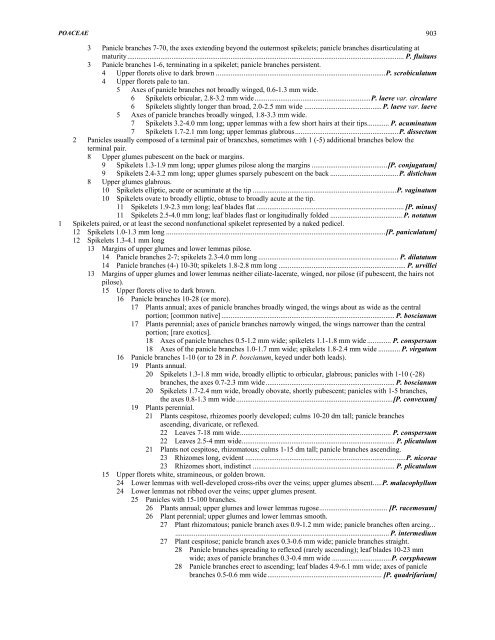Part 7 - UNC Herbarium
Part 7 - UNC Herbarium
Part 7 - UNC Herbarium
You also want an ePaper? Increase the reach of your titles
YUMPU automatically turns print PDFs into web optimized ePapers that Google loves.
POACEAE 903<br />
3 Panicle branches 7-70, the axes extending beyond the outermost spikelets; panicle branches disarticulating at<br />
maturity...................................................................................................................................................... P. fluitans<br />
3 Panicle branches 1-6, terminating in a spikelet; panicle branches persistent.<br />
4 Upper florets olive to dark brown ............................................................................................P. scrobiculatum<br />
4 Upper florets pale to tan.<br />
5 Axes of panicle branches not broadly winged, 0.6-1.3 mm wide.<br />
6 Spikelets orbicular, 2.8-3.2 mm wide...............................................................P. laeve var. circulare<br />
6 Spikelets slightly longer than broad, 2.0-2.5 mm wide .......................................... P. laeve var. laeve<br />
5 Axes of panicle branches broadly winged, 1.8-3.3 mm wide.<br />
7 Spikelets 3.2-4.0 mm long; upper lemmas with a few short hairs at their tips............ P. acuminatum<br />
7 Spikelets 1.7-2.1 mm long; upper lemmas glabrous........................................................P. dissectum<br />
2 Panicles usually composed of a terminal pair of brancxhes, sometimes with 1 (-5) additional branches below the<br />
terminal pair.<br />
8 Upper glumes pubescent on the back or margins.<br />
9 Spikelets 1.3-1.9 mm long; upper glumes pilose along the margins .........................................[P. conjugatum]<br />
9 Spikelets 2.4-3.2 mm long; upper glumes sparsely pubescent on the back .....................................P. distichum<br />
8 Upper glumes glabrous.<br />
10 Spikelets elliptic, acute or acuminate at the tip ..............................................................................P. vaginatum<br />
10 Spikelets ovate to broadly elliptic, obtuse to broadly acute at the tip.<br />
11 Spikelets 1.9-2.3 mm long; leaf blades flat ................................................................................ [P. minus]<br />
11 Spikelets 2.5-4.0 mm long; leaf blades flast or longitudinally folded ....................................... P. notatum<br />
1 Spikelets paired, or at least the second nonfunctional spikelet represented by a naked pedicel.<br />
12 Spikelets 1.0-1.3 mm long .......................................................................................................................[P. paniculatum]<br />
12 Spikelets 1.3-4.1 mm long<br />
13 Margins of upper glumes and lower lemmas pilose.<br />
14 Panicle branches 2-7; spikelets 2.3-4.0 mm long ............................................................................ P. dilatatum<br />
14 Panicle branches (4-) 10-30; spikelets 1.8-2.8 mm long ..................................................................... P. urvillei<br />
13 Margins of upper glumes and lower lemmas neither ciliate-lacerate, winged, nor pilose (if pubescent, the hairs not<br />
pilose).<br />
15 Upper florets olive to dark brown.<br />
16 Panicle branches 10-28 (or more).<br />
17 Plants annual; axes of panicle branches broadly winged, the wings about as wide as the central<br />
portion; [common native].............................................................................................. P. boscianum<br />
17 Plants perennial; axes of panicle branches narrowly winged, the wings narrower than the central<br />
portion; [rare exotics].<br />
18 Axes of panicle branches 0.5-1.2 mm wide; spikelets 1.1-1.8 mm wide ............. P. conspersum<br />
18 Axes of the panicle branches 1.0-1.7 mm wide; spikelets 1.8-2.4 mm wide ............ P. virgatum<br />
16 Panicle branches 1-10 (or to 28 in P. boscianum, keyed under both leads).<br />
19 Plants annual.<br />
20 Spikelets 1.3-1.8 mm wide, broadly elliptic to orbicular, glabrous; panicles with 1-10 (-28)<br />
branches, the axes 0.7-2.3 mm wide...................................................................... P. boscianum<br />
20 Spikelets 1.7-2.4 mm wide, broadly obovate, shortly pubescent; panicles with 1-5 branches,<br />
the axes 0.8-1.3 mm wide.....................................................................................[P. convexum]<br />
19 Plants perennial.<br />
21 Plants cespitose, rhizomes poorly developed; culms 10-20 dm tall; panicle branches<br />
ascending, divaricate, or reflexed.<br />
22 Leaves 7-18 mm wide.................................................................................. P. conspersum<br />
22 Leaves 2.5-4 mm wide................................................................................... P. plicatulum<br />
21 Plants not cespitose, rhizomatous; culms 1-15 dm tall; panicle branches ascending.<br />
23 Rhizomes long, evident .......................................................................................P. nicorae<br />
23 Rhizomes short, indistinct ............................................................................. P. plicatulum<br />
15 Upper florets white, stramineous, or golden brown.<br />
24 Lower lemmas with well-developed cross-ribs over the veins; upper glumes absent.....P. malacophyllum<br />
24 Lower lemmas not ribbed over the veins; upper glumes present.<br />
25 Panicles with 15-100 branches.<br />
26 Plants annual; upper glumes and lower lemmas rugose..................................... [P. racemosum]<br />
26 Plant perennial; upper glumes and lower lemmas smooth.<br />
27 Plant rhizomatous; panicle branch axes 0.9-1.2 mm wide; panicle branches often arcing...<br />
.................................................................................................................... P. intermedium<br />
27 Plant cespitose; panicle branch axes 0.3-0.6 mm wide; panicle branches straight.<br />
28 Panicle branches spreading to reflexed (rarely ascending); leaf blades 10-23 mm<br />
wide; axes of panicle branches 0.3-0.4 mm wide ................................P. coryphaeum<br />
28 Panicle branches erect to ascending; leaf blades 4.9-6.1 mm wide; axes of panicle<br />
branches 0.5-0.6 mm wide.............................................................. [P. quadrifarium]













